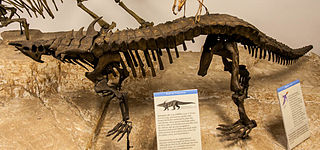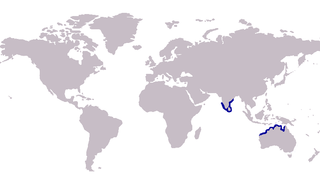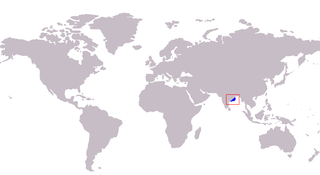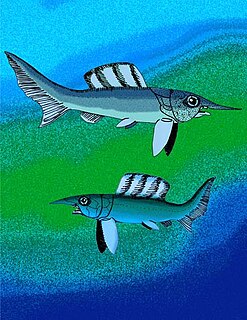
The Peninsular rock agama or South Indian rock agama is a common species of agama found on rocky hills in south India. An allied species, Psammophilus blanfordanus, is found in the Eastern Ghats, but north of the range of this species.

Bothriolepis was a widespread, abundant and diverse genus of antiarch placoderms that lived during the Middle to Late Devonian period of the Paleozoic Era. Historically, Bothriolepis resided in an array of paleo-environments spread across every paleocontinent, including near shore marine and freshwater settings. Most species of Bothriolepis were characterized as relatively small, benthic, freshwater detritivores, averaging around 30 centimetres (12 in) in length. However, the largest species, B. rex, had an estimated bodylength of 170 centimetres (67 in). Although expansive with over 60 species found worldwide, comparatively Bothriolepis is not unusually more diverse than most modern bottom dwelling species around today.
Ichthyology uses several terms that are unique to the science.

Desmatosuchus is an extinct genus of archosaur belonging to the Order Aetosauria. It lived during the Late Triassic.

Epinephelus albomarginatus, the white-edged grouper, white-edged rockcod or captain fine, is a species of marine ray-finned fish, a grouper from the subfamily Epinephelinae which is part of the family Serranidae, which also includes the anthias and sea basses. It is found in the southwestern Indian Ocean and it is associated with coral reefs. It is a target species for commercial and recreational fisheries.
Cherax parvus is a species of crayfish in the family Parastacidae. It is only known from its type locality – the Upper Tully River catchment in the Cardwell Range of north-eastern Queensland – and is listed as Data Deficient on the IUCN Red List. It was discovered in a rainforest catchment in a highland of northeastern Queensland during a Queensland Museum expedition to the upper Tully River area in November 1992. It is one of the smallest species in the genus. No species of Cherax has been considered endemic to wet upland or highland areas before it was discovered; most previous records were from elevations less than 400 meters. It also has several morphological features unique to the genus, and does not appear closely related to any extant species, suggesting a long period of geographic isolation.

Anatosuchus is an extinct genus of notosuchian crocodylomorph discovered in Gadoufaoua, Niger, and described by a team of palaeontologists led by the American Paul Sereno in 2003, in the Journal of Vertebrate Paleontology. Its duck-like snout coincidentally makes it resemble a crocoduck, an imagined hybrid animal with the head of a crocodile and the body of a duck.

Ogoveidae is a family of harvestmen with three described species in one genus, Ogovea, which is found in equatorial West Africa.

The mud whiting, Sillago lutea, is a species of coastal marine fish in the smelt-whiting family Sillaginidae. The mud whiting was first described in 1985 and is currently known from the north west coast of Australia and the Indian coast.

The Soringa whiting, Sillago soringa, is a poorly known species of coastal marine fish of the smelt-whiting family, Sillaginidae. The Soringa whiting is known exclusively from the east coast of India, inhabiting shallow inshore environments, particularly sandy substrates. S. soringa was first described in 1982 by Dutt and Sujatha, with the taxonomic status of the species was questioned by Roland McKay in his review of the Sillaginidae, with similar features to S. asiatica suggesting it is a senior synonym of the latter.

Holonema is an extinct genus of relatively large, barrel-shaped arthrodire placoderms that were found in oceans throughout the world from the Mid to Late Devonian, when the last species perished in the Frasnian-Fammian extinction event. Most species of the genus are known from fragments of the armor, but the Gogo Reef species, H. westolli, is known from whole, articulated specimens. According to these specimens, species of Holonema lived by grazing on stony, horn-shaped, stromatolite-like algae called oncholite, apparently by snipping off the points with a specialized snout.

The coastal trevally, also known as the onion trevally, Japanese trevally or bluefin kingfish, is a species of inshore marine fish in the jack family Carangidae. The species is distributed throughout the tropical and subtropical waters of the Indian and west Pacific Oceans, from South Africa in the west to Japan and New Caledonia in the east, reaching as far south as Australia. The species is found on deep coastal reefs, both in schools and as solitary individuals, where they prey on small midwater organisms including crustaceans, small fish and cephalopods. The species is taken as bycatch in a number of fisheries throughout its range by a number of fishing methods and is of little commercial value, but is considered to be a good table fish. A mistype in the original volume in which Eduard Rüppell named the species led to the combination Carangoides caeruleopinnatus, which has incorrectly spread through the literature.

The blue trevally, also known as the banded trevally, barred trevally, Ferdau's trevally or Forskaal's jackfish, is a common, widespread species of pelagic marine fish classified in the jack family, Carangidae. The blue trevally is distributed throughout the tropical and subtropical waters of the Indo-Pacific and central Pacific regions, ranging from South Africa in the west to Hawaii in the east. It is a moderately large fish, growing to a recorded maximum length of 70 cm, with the number of rays in the second dorsal fin and the colouring serving as diagnostic features of the species. The species inhabits waters to depths of 60 m, generally inhabiting reefs, beaches, lagoons, and areas with sandy substrates. It is a predatory fish, taking other fish, prawns, crabs, and molluscs, and very little is known of the species' reproductive biology. The blue trevally is of varying importance to fisheries throughout its range, with some regions having high catches of the fish. It is considered to be a gamefish, and is sought after for its excellent eating qualities.
Chaceon bicolor is a species of crab. Chaceon bicolor differs from all species of the genus in color pattern, with the anterior part of the body purplish rather than reddish. In addition to color pattern, C. bicolor also differs from C. granulatus in having compressed rather than depressed dactyli on the walking legs; also, the hepatic region of the carapace in C. granulatus is coarsely granular, whereas it is smooth in C. bicolor. Juvenile specimens differ from adults in many features: the teeth of the carapace are much larger and sharper, there is a sharp spine on the carpus of the cheliped and a distal spine on the merus of each walking leg, plus the legs are longer and slenderer. Adult females differ from males in having much sharper anterolateral teeth on the carapace, sharper suborbital spines, and much shorter legs, with less trace of a distal dorsal projection on the merus. The carapace of females is more strongly arched from front to back and the protogastric regions are noticeably more inflated. The species is named as such because of its colour patter, purple an tan.

Oxyosteus is a genus of trout-sized, highly compressed arthrodire placoderms from the Late Devonian of Europe: The two described species are restricted to the Late Frasnian-aged Kellwasserkalk Fauna of Bad Wildungen, while a median dorsal plate of an unnamed species is known from the Middle Frasnian Holy Cross Mountains of Poland.
Microbrachius is an extinct genus of tiny, advanced antiarch placoderms closely related to the bothriolepids. Complete articulated specimens show that the armored section of the body had an average length of 2-4 cm. Species of Microbrachius are characterized by having large heads with short thoracic armor. Specimens of Microbrachius have been found in Scotland, Belarus, Estonia, and China. Specimens range in age from the Lower Devonian Late Emsian Stage to the Middle Devonian Upper Givetian Stage.
Salvatoria koorineclavata is a species belonging to the phylum Annelida, a group known as the segmented worms. A related species in Australia has been described as Brania clavata and subsequently as Salvatoria clavata. While similar, the Australian species has a longer pharynx and proventricle; at the same time, blades of chaetae are present in the Australian species, with longer and upwards curved spines, which are straight in S. clavata; its pharyngeal tooth is located more anteriorly than in S. clavata. Other global species, like those in the genus Brania, are also similar to S. koorineclavata. Salvatoria californiensis has similar chaetae, with shorter spines and less developed teeth. Its acicula lacks a defined acute tip, and the proventricle is quite shorter, running through 5 segments in S. koorineclavata, with fewer rows of muscle cells. The species name comes from an Aboriginal word, Koorine, meaning "daughter", due to the similarity of the Australian species to the European species of S. clavata.

Sphaerosyllis levantina is a species belonging to the phylum Annelida, a group known as the segmented worms. It was first described from Haifa Bay in the eastern Mediterranean. It is similar to Sphaerosyllis hystrix, and is thought to show a cosmopolitan distribution. Its name derives from its type locality, levantina being the feminine form of a neo-Latin adjective meaning "pertaining to the region where the sun raises"; the adjective is feminine to agree with the feminine genus name, Syllis being a river nymph in Greek mythology.
Erinaceusyllis cirripapillata is a species belonging to the phylum Annelida, a group known as the segmented worms. E. cirripapillata is characterized by its papillae on its dorsal cirri, one of them being distinctively mushroom-shaped. No species of this genus or Sphaerosyllisis is known to possess this particular kind of papillae. The name of the species refers to these same papillae.
Parapionosyllis winnunga is a species belonging to the phylum Annelida, a group known as the segmented worms. Parapionosyllis winnunga is characterized by the shape of the blades of its compound chaetae, which have a long subdistal spine, in turn much longer than in other cogenerate species. Its species name is derived from the Aboriginal word winnunga, meaning "small".


















